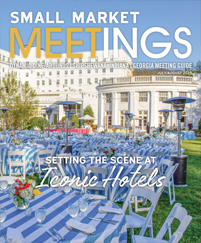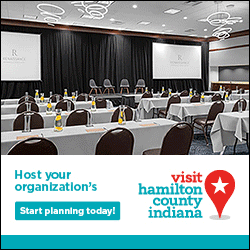It’s easy for organizations to get swept up in the exciting idea of creating new events. Visions of packed ballrooms and large profit margins often propel these new events forward, even though planners know the reality of launching an event often entails guesswork, skepticism and setbacks. So, what are the major differences between planning a recurring event and a new event? How should one assess the event and its needs without a history? And how do organizations get stakeholders to co-sign their new event’s success?
Here’s what three expert planners had to say about launching new events.
Assess the Need
When an organization comes to a planner with the idea for a new event, planners typically find that these organizations have grand ideas but haven’t yet done the work to justify the event’s creation.
“All too often, groups are enamored with the idea,” said Heather Sampson, founder and CEO of her planning company, Aspire Meetings and Events. “But if they don’t have an audience to draw from, or they’re not filling a critical need, it’s going to be a really hard sell.”
When an organization first conceptualizes a new event, it’s especially important for them to be able to identify its purpose, or “the why.” This process requires them to research their current industry, ask what needs aren’t being met by similar events, identify problems within their industry and determine what would make this new event stand out.
“In my experience, a lot of these ideas stem from strategic dialogue with your leadership, and a lot of it is built around a pain point,” said Leah Lewis, senior director of education and events at the American Gear Manufacturers Association. “So maybe there’s a problem or a challenge that the industry is facing, and there is a new need for people to get together to talk about issues or learn about a new challenge.”
Once they have developed an understanding of their event’s purpose, they can then begin to flesh out its goals and objectives, which are critical to the planning process. Whether it’s fundraising or filling an educational need, determining the event’s objectives ensures the rest of the event details come into sharper focus. Specific and measurable objectives help a planner develop every other aspect of the event, from brand messaging to the target audience and even logistical factors such as venue.
“When you’re starting a new event, you’re trying to sell the idea of what your event is,” said Melanie Fransen, owner of In Any Event, who works primarily with nonprofit associations. “It has to have a strong voice and a strong purpose to attract your attendees and to solicit sponsors.”
Knowing “the why” can also help planners when it comes to measuring the event. Without a history to compare it to, usual metrics like attendance or profit aren’t always the best way to determine ROI. Alternative ways to assess ROI can include things like pre- and post-event surveys to assess growth in attendees’ skill levels or evaluations with long-form feedback to measure stakeholder satisfaction.
Reach the Target Audience
Once the event’s purpose is in focus, its target audience is easier to identify. Event organizers should have a very clear picture of the ideal attendee’s demographic information. If the goal is fundraising, for example, young professionals likely aren’t going to be the target group. But if the goal is training and networking to bridge a generational gap within the workforce, they’ll make the cut.
Once they’ve identified the type of attendee that is the best fit for their event, planners must build a list. Associations benefit from having an existing member list they can sample from, but other groups may have to rely on surveys, focus groups or attendance lists from other similar events or associations.
“You really need to know who you’re targeting,” Sampson said. “Build up an email list and database of who you plan on promoting this to.”
The best way to reach attendees differs based on the target audience, but two things are certain: promoting the event to them is incredibly important, and there will need to be more promotion for a new event than a recurring event.
“You don’t have a built-in audience yet, so there is a lot of special marketing that needs to be happening because you’re not only trying to get people there, but you’re also having to explain what the event is,” Lewis said. “I think this is a case where the meeting planner needs to be very aligned with their marketing and communications team.”
Sampson suggested ramping up the frequency and volume of the marketing efforts for new events compared to recurring events.
“To me, it’s far more frequent, and you need to have more messaging out there,” she said. “Pushing things through on social media is key and also sharing some marketing tools with speakers and others who can help spread the word.”
Other outside-the-box ideas for promoting attendance at a new event include special promotion for early registration, a partnership with sponsors or speakers to promote the event in the months leading up to it and working with an industry media outlet or brand ambassador for promotion.
Promote Stakeholder Success
When it comes to new events, it’s not just the event organizers that are putting themselves out there; all stakeholders — the vendors, sponsors, exhibitors and attendees — are assuming varying levels of risk because the event doesn’t have a history. That’s why it can be more difficult to get them onboard. To promote the event’s success, and therefore the stakeholders’ success, transparency and flexibility are both key.
When it comes to site selection, it’s important to choose a destination, hotel and vendor partners that can offer this flexibility. Highly competitive markets have less room for guessing about room blocks, catering and meeting space when an event doesn’t have a history to draw from. Meanwhile, second- and third-tier cities are more likely to bid on an event and leave some wiggle room in the contract for cost-savings and budget adjustments.
It can be much more challenging to attract sponsors for a first-time event than a recurring event.
“It is difficult because we all know sponsorship dollars are limited,” Fransen said. “So, when we’re building the events, you have to look at it from a sponsorship perspective and ask, ‘How can we feature your company so that you have an ROI?’”
This can include designing the event in a way that maximizes face time between sponsors and attendees, giving them a great rate for the first year, or making them feel like they have a stake in the success of the event.
“I would say that transparency is going to be really important, and you should give them an opportunity to get in on the ground level,” Lewis said. “Maybe you make the sponsorship package really affordable and enticing the first year because you don’t know what to expect, and you don’t want to make promises that you can’t keep.”
Another trick that may help get the event off the ground via stakeholders is to bring in a partner organization to help assume some of that financial risk. Whether that’s a sister organization or a group with overlapping membership, partnerships can be another way for event organizers to test the waters.
Managing expectations of stakeholders — including event organizers — is also critical. From a financial standpoint, first-time events often break even or have minor losses, so making sure everyone involved has realistic expectations about the event’s outcomes will make sure there are no surprises or displeased stakeholders.
“In my experience, your first-time events, even when they’re a success, I’m not going to say they’re a guaranteed home run,” Fransen said. “So, you have to manage the expectations back at the early stages.”












